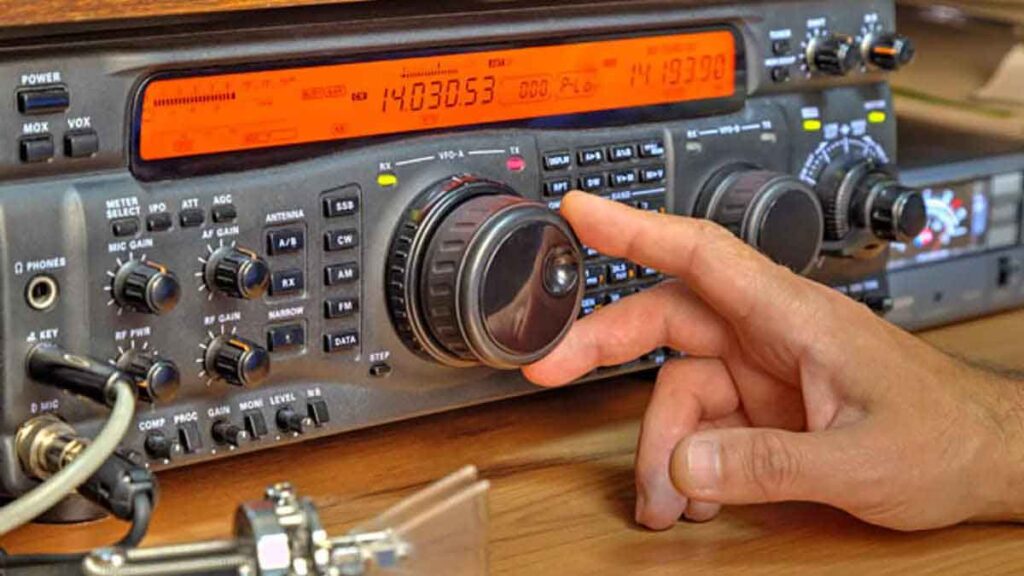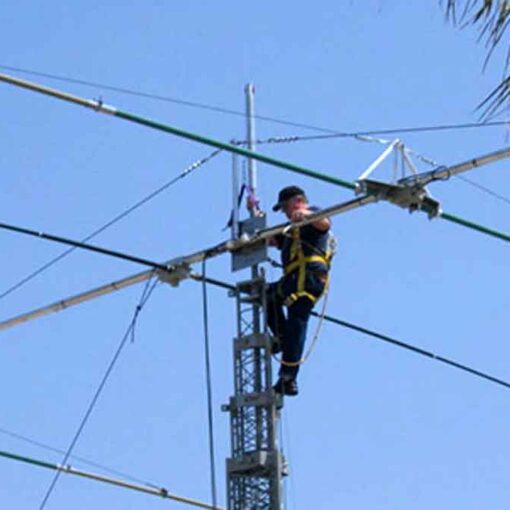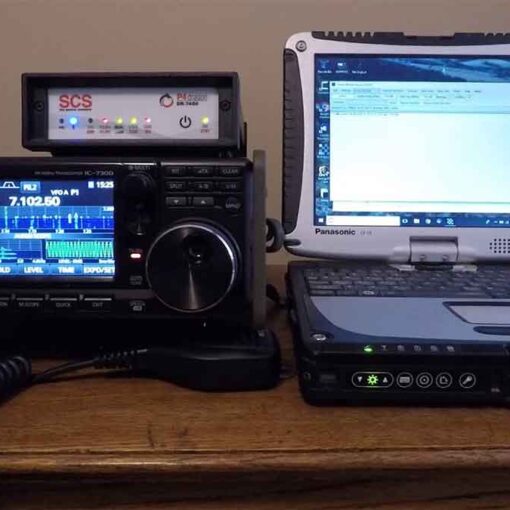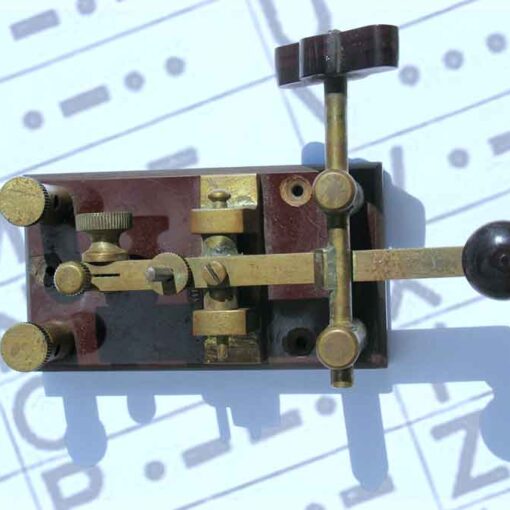We assume that W1ZZZ matches your CQ:
“LZ2ZZZ DE W1ZZZ W1ZZZ AR”,
or
“LZ2ZZZ DE W1ZZZ W1ZZZ K”,
or even:
“W1ZZZ W1ZZZ K”,
or
“W1ZZZ W1ZZZ AR”.
When answering a CQ, do not transmit the initial of the station you are calling more than once, even better not transmit it once (you must trust that the operator knows his initial…).
What should the calling station end their call with – “AR” or “K”?
Both are equally acceptable. “AR” means “End of transmission” while “K” means “Transfer to you”. The latter sounds a little more optimistic, since the station you are calling may not answer you, but another station…
However, there is good reason to use “AR” rather than “KN”. “AR” is a merged character (see above), meaning that the letters A and R are transmitted without a space between them. If, however, “K” is transmitted, and if the letter “K” is relatively close to the call sign, the letter “K” may be considered the last letter of the initial. This happens all the time. With “AR” this is absolutely impossible because “AR” is not a letter. Often none of the codes are used (neither “AR” nor “K”), which increases the risk of making mistakes.
We assume you wish to answer W1ZZZ calling you. You need to do this as follows:
“W1ZZZ DE LZ2ZZZ GE (good evening) TKS (thank you) FER (for) UR (your) CALL (call) UR RST 589 589 NAME BOB BOB QTH LEEDS LEEDS HW CPY (how did you receive?) W1ZZZ DE LZ2ZZZ K”.
This time is the time to use the “K” at the end of your delivery. “K” stands for “transfer to you” and you are W1ZZZ.
Do not end the transmission with “AR K”: it means “End of transmission, transfer to you”. It is clear that when you transfer to the other station, you are done with the transmission, there is no need to say so. End each of your transmissions during a QSO with “K” (or “KN” when necessary – see above). It is true, we often hear “AR K”, but this is not correct.
The reason for the incorrect use of “AR”, “K”, “KN”, “AR K” or “AR KN” is that many operators do not really know what each of these abbreviations mean. Let’s use them faithfully!
We clarified that it is not necessary to use the term “PSE” (please) at the end of the CQ; don’t use it at the end of your show either. So, no “PSE K” or “PSE KN”. Let’s keep things simple and drop the “PSE” please…
On the VHF bands (or above) it is normal to exchange a QTH-locator. This is a code that communicates the geographic location of your station (eg: KN12PQ).
RST report: R and S are derived from Readability (1 to 5) and Signal Strength (1 to 9) as used in telephony (see above), and T (1 to 9) in the signal report is derived from Ton. The number indicates the purity of the sound in the CW signal, which should be pure sinusoidal without distortion.
Official tone rating in RST rating
| T1 | 60 Hz (or 50 Hz) hum, extra coarse and wide |
| T2 | Too harsh hum, very hoarse signal |
| ТЗ | Rectified AC hum, but not filtered |
| T4 | Broom, some signs of filtering |
| Т5 | Filtered AC but heavily overmodulated tone |
| T6 | Filtered tone, obvious traces of overmodulation |
| T7 | Near clean tone, traces of overmodulation |
| T8 | Near perfect tone, slight traces of overmodulation |
| T9 | Perfect tone, no trace of overmodulation |
The original descriptions evaluating the various cases of T date back to the early years of ham radio, when a pure CW tone was the exception rather than the rule. The table above describes the modern CW tone ratings as published in 1995 (source: W4NRL).
In practice, we mainly use only a few levels of T, the definition of which corresponds to the general state of technology today:
Modern practical use of pitch estimation in RST estimation
| T1 | deeply modulated CW, elements of wild oscillations, or extremely rough AC (means: get off the air with such a bad signal!) |
| T5 | very noticeablethe AC component (often due to a poorly regulated transmitter or amplifier power supply) |
| T7
T6 T7 T8 |
slight, barely noticeable AC component |
| T9 | perfect pitch, undistorted sine wave |
Nowadays, the most common defects of the CW signal are chirp and the even more common click or click of the switch (see below).
Chirps and clicks used to be very common problems with the CW signal: every operator knew that 579C was a report that meant a chirping signal, and 589K meant a key click. Few hams today know what the “C” and “K” at the end of the RST report mean, so you better transmit “CHIRP” or “BAD CHIRP” and “CLICKS” or “BAD CLICKS” in whole words as part of your report.
A typical way of politely ending a connection would be: “…TKS (thanks) FER QSO 73 ES (and) CUL (see you again) W1ZZZ DE LZ2ZZZ SK”. “SK” is a fused character meaning “end of connection”.
“TI TI TI TAA TI TAA” is the fused character “SK”, not “VA” as published in some places (SK delivered without a space between the two letters sounds the same as VA delivered without a space between the letters) .
Do not transmit “AR SK”. It is nonsense. You say “End of transmission” plus “End of connection”. It is quite obvious that the end of the relationship is also the end of your transmission. You may often hear “AR SK”, but “AR” is redundant, so avoid it.
If at the end of the QSO you intend to turn off your station, you should transmit: “W1ZZZ DE LZ2ZZZ SK CL” (“CL” is a fused character meaning “turn off” or “cease operation”).
An overview of the codes passed at the end:
Codes transmitted at the end of a session
| CODE | MEANING | USE |
| AR | end of transmission | at the end of CQ and at the end of your transmission when you call a station(1) |
| K | transfer to you | at the end of the “over” (2) and at the end of your broadcast when calling any station |
| KN | transfer to you only | at the end of “over” |
| ARK | end of transmission + transfer to you | DO NOT use it |
| ARKN | end of transmission + transfer only to you | DO NOT use it |
| SK | end of connection (the QSO) | at the end of the QSO |
| ARSK | end of transmission + end of connection | DO NOT use it |
| SKCL | end of QSO, turning off station | when you switch off |
(1) when responding to a station that has called CQ or QRZ.
(2) a handover or over is not the same as a QSO (link). A QSO usually consists of a series of overs.
Typical CW QSO for beginners:
QRL? QRL? CQ CQ G4ZZZ G4ZZZ CQ CQ G4ZZZ G4ZZZ AR G4ZZZ DE ON6YYY ON6YYY AR ON6YYY DE G4ZZZ GE TKS FER CALL UR RST 579 579 MY NAME BOB BOB QTH HARLOW HARLOW HW CPY? ON6YYY DE G4ZZZ K G4ZZZ DE ON6YYY FB BOB TKS FER RPRT UR RST 599 599 NAME JOHN JOHN QTH NR GENT GENT G4ZZZ DE ON6YYY K ON6YYY DE G4ZZZ MNI TKS FER RPRT TX 100 W ANT DIPOLE AT 12M WILL QSL VIA BURO PSE UR QSL TKS QSO 73 ES GE JOHN ON6YYY DE G4ZZZ K G4ZZZ DE ON6YYY ALL OK BOB HERE TX 10 W ANT INV V AT 8M MY QSL OK VIA BURO 73 ES TKS QSO CUL BOB G4ZZZ DE ON6YYY SK 73 JOHN CUL DE G4ZZZ SK
Using BK
“VK” (break) is used to quickly switch between the two stations without exchanging call signs at the end of the transmission. As used in CW, it is equivalent to “over” in telephony.
Example: W1ZZZ wants to know the name of LZ2ZZZ with whom he is in contact and transmits: “..UR NAME PSE BK”. LZ2ZZZ replies immediately: “VK NAME JOHN JOHN BK”.
The break is announced with “VK” and the correspondent’s transmission also begins with “VK”. This second VC, however, is not always practiced.
Even faster
Often tothe “VK” code is not used. A momentary pause in transmission (on break standby, meaning you listen between words or letters) allows the other station to begin transmitting, just as in a normal face-to-face conversation, where each of the two takes the floor without any formality.
Using the fused character AS (DIT DAH DIT DIT DIT)
If during a QSO someone interferes (transmitting your initial at the same time as the station you are working with, or at the moment you are transferring the transmission to that station) and you want to let them know that you wish to finish the current QSO first, simply transmit “AS” , which means “wait” or “hold”.
Use of KN
“K” = “over”. By transmitting only “K” at the end of your transmission, you leave the door open for other stations to step in. If you don’t want to be interrupted, transmit “KN”.
“KN” means that you want to hear ONLY the station whose call sign you just transmitted (= “you go, others wait” or “over just for you”). In other words: no break during this time, please.
“KN” is mainly used when there is chaos around. Possible scenario: different stations respond to your CQ. You partially accept one of the initials and transmit: “ON4AB? DE LZ2ZZZ PSE UR CALL AGN (again) K”. The station ON4AB? answers, but other stations are calling you at the same time, making it impossible to receive his initial. The procedure is to call ON4AB? again and end your call with “KN” instead of “K”, thus emphasizing that you want to hear ON4AB’s answer?. Example: “ON4AB? DE LZ2ZZZ KN” or even “ONLY ON4AB? DE LZ2ZZZ KN N N” (c extra pauses between the letters N). You are really nervous now…




